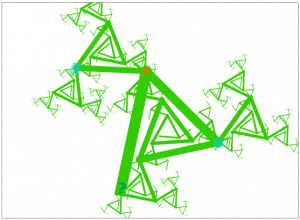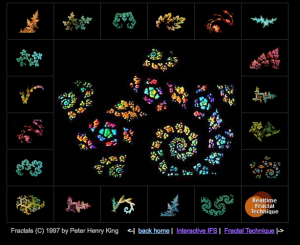A Series Spotlighting Real-Life Examples of Art Meeting Code (Part 3 of 4)
Peter King has been experimenting with fractals since the mid-1980s. Many of his designs take their input from nature and from human interaction — in the form of video camera inputs or a “Spirograph” style user experience — rather than from a fixed mathematical starting point. He invented a process to create fractals purely from video camera feedback — no computer necessary!
Forms that exhibit scalar self-similarity, combined with the fact that in-folding greater detail increases the measure of the geometry: The more convoluted a (one dimensional) line gets, the more it approaches filling a two dimensional plane, so the line exists in a fractional dimension, hence, fractal. Romanesco and Buddabrot are among my favorites.
 What got you interested in fractals?
What got you interested in fractals?
Growing up, I loved to draw from my imagination and from life. As a senior in High School (1982), I was seduced by computer graphics, and wrote little programs on Apple II written in Basic. There was no command for a circle, so found out how sine & cosine are used to draw a circle with a for loop. It was all Euclidean geometry: First spirals and spirographs, then wrote a 3D wireframe program in Basic. But with all that focus on euclidean geometry, my drawings were getting really geometric, and I began missing the organic feel of natural structures.
Then in college a friend sent me an article on fractals and the mandelbrot set, and I was attracted by the psychedelic appeal, but also liked how well they described organic structures algorithmically. My math skills weren’t apt for fractal math, so I would draw fractals to help myself understand them. Just out of college I watched a NOVA episode on fractals and chaos theory, which gave a very simple description of how to draw a Sierpinski triangle, so after watching I went to my Amiga and wrote a basic program to do it, and then began tweaking the variables to see how it changed the fractals.
 A couple years later, I was experimenting with video feedback. I really liked observing how it behaved similarly to cellular automata: There was chaotic emergence guided by recursive rules. I think the universe creates in a similar way, so engaging in creative process this immediate and responsive manner feels to me like collaborating with nature. Well, in these explorations, I wondered what would happen if I split the camera signal and sent it to two monitors. While I set things up, I realized it would make fractals, which was a very exciting realization. I refined the video fractal process by putting one video monitor behind a window, with the reflection of the second monitor superimposed. This creates very specific IFS fractals, but they pulse and throb with color and texture. Truly simple shamanic interactive television 🙂
A couple years later, I was experimenting with video feedback. I really liked observing how it behaved similarly to cellular automata: There was chaotic emergence guided by recursive rules. I think the universe creates in a similar way, so engaging in creative process this immediate and responsive manner feels to me like collaborating with nature. Well, in these explorations, I wondered what would happen if I split the camera signal and sent it to two monitors. While I set things up, I realized it would make fractals, which was a very exciting realization. I refined the video fractal process by putting one video monitor behind a window, with the reflection of the second monitor superimposed. This creates very specific IFS fractals, but they pulse and throb with color and texture. Truly simple shamanic interactive television 🙂
When digital desktop video arrived, I switched to that medium, making versions with Max/MSP, Quartz Composer, and Flash. When the iPhone came out, I built a multitouch table, where the fractal is directly manipulated with multitouch gestures on affine transforms.
What preparation/skills did you need to acquire for these projects?
Programming skill progression: Basic, HyoerTalk (Hypercard), Flash Actionscript 3, Nodal noodle programming, such as Max/MSP, Pixelshox, Quartz Composer. Presently: HTML5 / css3 / javascript
Why create artwork that takes its inputs from outside phenomena (variables found in nature, interpolated by mathematical equations) rather than directly from the artist’s imagination?
I am fascinated by how nature designs, and by studying and imitating these processes, I feel like I am co-creating with nature.
Use the links below to check Peter King’s fractals — or make your own!

